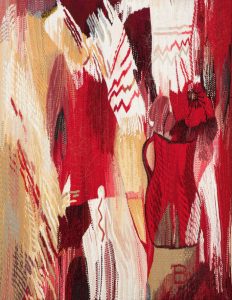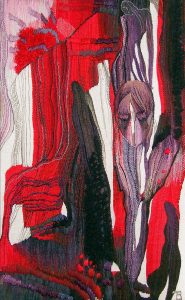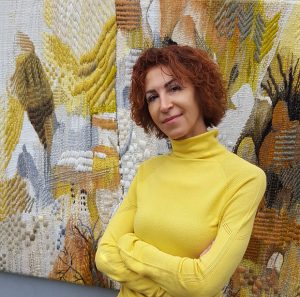Honoured Artist of Ukraine Tetiana Vytiahlovska was presented the Excellence Award for her modern tapestry – Desire for Light (Прагнення до світла).
Tetiana’s creations are both figurative and non-figurative, finding inspiration in the culture, legends and myths of Ukraine. She invests most of her creative energy in tapestry weaving, but also works with batik, oil and aquarelle.
Describing her work, the artist underlines the central element in her work – Light, a symbol of rejuvenation of nature and man. Tetiana says that the theme of Light runs through most of her work and constitutes a basic organic element.
“Light is a symbol of hope, the renewal of nature and man, an awareness of the meaning of life. He who does not seek Light is doomed to remain in the shadows forever.”

Zbruc sat down with Tetiana Vytiahlovska to discuss her work and the art of tapestry weaving
– Light is deeply and organically intertwined into fiber art through the materials used by tapestry artists, namely wool, which radiates a certain harmony and warmth. In addition, lines are an essential component of this technique, as they convey a sense of dynamic movement… vertical strokes that penetrate the tapestry like rays. Tetiana, do you think that tapestries add warmth to a space?
– Actually, the word “wool” is closely associated with heat and warmth. In addition, this natural material protects, diffuses vital energy and creates a comfortable atmosphere. When I caress a woolen fabric, it feels like the surrounding world is getting warmer and warmer.
The energy that I invest in the creation of my tapestries – and this is a complex and long-term process – is transformed into a deep sense of warmth, which the viewer perceives and senses at a psychological level.

– What materials do you use? How does the material or a fiber affect the mood of your tapestry?
– Tapestry weaving is a symbiosis of colour and texture. Texture is a specific means of expression for this type of art; it forms the plastic plane.
Different fibers – acrylics, linen, cotton and, of course, traditional wool – create a bright texture. I intertwine smooth weaves with bulky threads. I use thick and thin yarn, applying a wide range of colours. This is how I evoke an extraordinary play of light and shadow in a spatially limited work area.

– It seems that you are drawn to warm tones…
– I don’t limit my colour palette. I love variety, so it all depends on my mood and state of mind. I often find myself unconsciously choosing clothes in the same colour or tone as the tapestry I’m working on.

– You once said: “Artistic weaving is a manual craft.” Tell us more about your feelings during this work process.
– I like to work late at night, when things settle down. I immerse myself in my creative world, where I hear music playing softly in the distance. My hands reach for the pencils and brushes and suddenly, colourful aquarelle spots and stains emerge on the white sheet of paper before me. They shimmer and complement one other, merge into abstract compositions, which my magic pencil or brush then transforms into images.

At that point, I turn and touch the warm wool, which is begging me to bring it to life. Weaves, threads, yarns… the night seems short. And so time passes, day after day…a symbiosis, a living dialogue between hands and threads that create a canvas in which I’ve invested part of my soul.
I’m convinced a lot depends on my mood and the feelings I experience during the creative period. I weave different emotions into my work – love, pain, joy, sorrow…

– When we look at your work, it’s quite clear that you’re interested in understanding Ukrainian history and Ukrainian cultural symbols. Are these topics important for you?
– Yes, Ukrainian traditions, customs and rituals have always fascinated me. Our people have an ancient culture and it’s a real treasure chest for an artist. When I sit down to work, I immerse myself in it, and a part of me remains there. The threads, yarns and fabrics seem to speak and connect the past, present and future.


– Even when you show a traditional subject in your work, it seems that you want us to view the scene from a modern angle. For example, the tapestry ‘A Well-known Plot or the Water was Tasty Once’, where we see a classic scene – a girl and a boy standing near a well. The atmosphere is lyrical; old-world elements stand out against the abstract background… and yet, we look at the scene through present-day eyes, noting that the “plot” is an old one and the water used to be “tasty”. What do you want to emphasize when working on traditional or historical elements in your story?
– I use colours, texture, composition and lines to convey my understanding of goodness and love, beauty, and sometimes the cruelty of the world, as well as the energy of all that is beautiful, given to us by God.

– The titles are often the key to understanding the metaphors in your creations. For example: ‘A Sad Boy with Nice Dreams’, ‘Water of Life in a Ripe Field’, ‘Webs for Happiness’… How are these titles born?
– Well, parents usually look for the most melodious, most appropriate name for their child, and so do I. Sometimes the right word appears instantly, and sometimes I carry names within me for days on end until I feel that I’ve found the right one.



– You’re obviously inspired by nature – abstract landscapes, still life compositions, scenes with semi-human figures. It’s interesting, but these figures are never distinctly separated from the landscape; they sort of melt into it. Are you influenced by natural forms, textures and ornaments?
– My sources of inspiration lie in the shapes and colours of our natural landscapes, the light touch of a spring breeze, the soothing rays of the sun, the mysterious romance of rain. These natural images fill me with strong emotions and create a mood and an intense desire to convey the powerful energy of nature and beauty.
Nature itself dictates the texture and ornaments that I use in my work. But, I must pay particular attention to natural manifestations, like the relief of a newly plowed field, the graphic waves of passing clouds, the pulsing or sometimes chaotic rhythm of the roofs, and so on.


– Human-like figures have appeared in many of your tapestries. Why are you interested in these images?
– It is through human figures that I can best convey the desired moods, emotions and feelings. Human relationships are eternal subjects in folklore and literature and constitute a great source of inspiration. However, my human figures always subtly resonate with natural motifs. After all, nature is perfect, it’s what surrounds us, and its best work is Man.


 Tetiana Vytiahlovska was born in Buchach, Ternopil Oblast on May 22, 1964. She currently lives and works with her sculptor husband Mykhailo in the village of Zavodske, Ternopil Oblast.
Tetiana Vytiahlovska was born in Buchach, Ternopil Oblast on May 22, 1964. She currently lives and works with her sculptor husband Mykhailo in the village of Zavodske, Ternopil Oblast.
Tetiana studied at the Department of Art Weaving of the Vyzhnytsia School of Applied and Decorative Arts (now known as the Vasyl Shkribliak Vyzhnytsia College of Applied Arts), then at the Department of Textile Design at the Lviv Institute of Applied and Decorative Arts (now – Lviv National Academy of Arts).
She has participated in many solo and group exhibitions in Ukraine and abroad.
Tetiana’s FB page: https://www.facebook.com/vytiaglovska/










